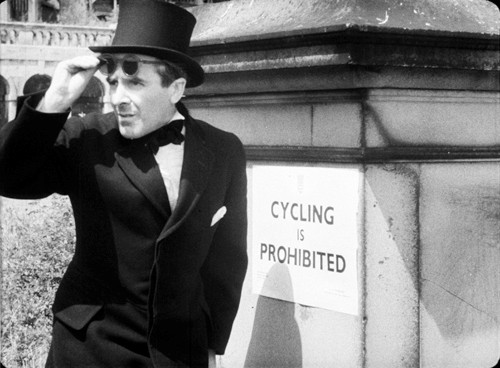The Pleasure Garden

The Pleasure Garden by James Broughton is a joyous musical fantasy celebrating Love in the Park. In this award-winning film the pleasure principle wins a sweet victory over all prudes and killjoys. Filmed in the United Kingdom in the ruins of The Crystal Palace Terraces, The Pleasure Garden is a playful and poetic ode to desire, and winner of the Prix de Fantasie Poétique at Cannes in 1954. The film features Hattie Jaques and Lindsay Anderson, with John Le Mesurier as the bureaucrat determined to stamp on any form of free expression.
The short film tells the story of a group of eccentrics gathered together in the remnants of the Crystal Palace (though the location isn’t of consequence in the film). They live a seemingly idyllic life, doing as they please. One man runs races, a woman rides her bike, another mimics the poses of the surrounding statues. They live their lives freely in pursuit of their desires until an ominous figure named Col. Pall K. Gargoyle and his accomplice, Aunt Minerva, arrive on the scene to enforce their rigid moral code. Signs are posted throughout the park to prohibit fun and individuals get thrown into captivity if they break the rules.
 Harmony is ultimately restored by freewheeling Mrs. Ablion, who makes the Garden’s inhabitants remember their passions and expel the Col. and his Aunt. Yes, the film is as odd as it sounds, but running just a little over 36 minutes, its unique brand of quirky and eccentric characters never wear out their welcome.
Harmony is ultimately restored by freewheeling Mrs. Ablion, who makes the Garden’s inhabitants remember their passions and expel the Col. and his Aunt. Yes, the film is as odd as it sounds, but running just a little over 36 minutes, its unique brand of quirky and eccentric characters never wear out their welcome.
Lovers of the history of Crystal Palace will find much to treasure in this 1950s time capsule of a film, which shows the Crystal Colonnade and the bandstand (both later demolished), the Royal Naval Volunteer Reserve Memorial, and much of the statuary which was to be auctioned off in 1957.
“In Chaplin, Rene Clair, Buster Keaton, Jacques Tati we enjoy on a big scale the fruits of the poetic turned comic. Broughton is of their kind, except that he holds more strongly to feeling, makes short cuts they daren’t, sees and sings out of himself, and never dilutes a joke or a movement. THE PLEASURE GARDEN thus combines the pleasure of Keystone with the love lyric. It springs like the lark, and mingles oddity, grace, satire, and laughter without a dead moment.” – Sight and Sound
“It’s on the side of the angels. It’s a great testimony for Love.” – Allen Ginsberg
Find out more about the man who created “The Pleasure Garden” in this new documentary: Big Joy: the Adventures of James Broughton
See Also:
The Road to Ruins: Art, Desire and the Crystal Palace
